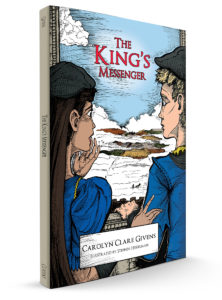Friends of Story Warren, you are likely familiar with our usual Friday post/newsletter, “The Warren & The World.” This bright spot of wonderfully curated news and interesting links from around the web (plus a recap of the week’s SW posts) comes from the witty and very bright mind of Carolyn Clare Givens. Carrie’s book for young readers, The King’s Messenger, is now out and about in the world and finding a home with families all over the place. It was a pleasure to chat a bit with Carrie and hear more about the background behind The King’s Messenger. You can find Glen’s great review of the book for Story Warren here, and pop over to Amazon to get yourself a copy.
First, I’d love to hear a little bit about your journey as a writer. Did you always want to be an author?
I don’t think I’d say I always wanted to be an author, but when I look back I realize that I have always been a storyteller. I’ve got a few of my stories from first grade and while they’re definitely not high literature, they show evidence of an imagination and a bent for spinning a tale. I was the youngest, and my mom’s philosophy is that a kid will process a story they listen to at the level they’re capable of, so she never thought any story was “too old” for me. I grew up listening in as she read classic literature to my older sisters, so I knew good stories from a really young age.
And how did The King’s Messenger come to life? Did you have an idea for the type of story you wanted to tell, or did it start with a character?
The King’s Messenger—like most of my writing—is character driven. I often “meet” my characters; they arrive with a personality already mostly intact that I then have the challenge of discovering. (I have actually taken Myers-Briggs-type personality surveys for characters sometimes, just to get a fuller understanding of who they are and how they might react given a certain circumstance.) Smuggins is no exception to my norm. He showed up in my mind one day in a class in college as we read Milton’s sonnet “On His Bindness,” a messenger who had never been called on to go—who was always waiting. So I had to tell his story to find out what he would do with that. The King’s Messenger came bit by bit that way—each chapter happened when the Smuggins living in my head discovered he had another lesson to learn.
Wow, so it’s been a long journey for Smuggins! How did you know when his story was finished?
I wrote the final chapter (“The King’s Land”) before Chapter 9 (“The King’s Ambassador”). I knew I’d reached the end of the story, but it didn’t quite feel complete. Part of that was story driven—there was something missing—and part of that was my love of orderly numbers: I wanted ten chapters, not nine. It was actually a few years later that I heard a message on 2 Corinthians 5:20, “Therefore we are ambassadors for Christ, God making his appeal through us. We implore you on behalf of Christ, be reconciled to God.” I knew immediately that was the final story to be told and I went home and wrote it.
One thing that really drew me in to the story is the epigraphs from classic works of literature that precede each chapter. They set the stage for the tone of the book; a deep, rich tale with meaning beyond what’s on the surface. Were you familiar with all those works before writing Smuggins’ story, or did you have to go hunting for the right epigraph for each chapter?
Mostly I had some familiarity—or the lesson Smuggins was learning would come out of my discovery of the epigraph quote. Milton was a huge influence on Smuggins’ story. Obviously, the first chapter was born out of the sonnet that begins, “When I consider how my light is spent…,” but when I read “Paradise Lost,” I knew that I would be pulling from it for Smuggins’ tale. That is an incredibly rich poem and there are so many themes that it points to. The epigraph of Chapter 2, “The King’s Silence,” is Psalm 123, and that came out of hearing someone preach on that psalm—I was so struck by the image of a servant watching the hands of their master. The reference to Psalm 55 in the epigraph of Chapter 3, “The King’s Friend,” came from an experience in high school where my youth group went through the pain of seeing one of our leaders fail morally. We gathered together the night that we were told in order to process our grief and pain and someone read that psalm—I’ve never been able to get it out of my head since. The epigraph from “The Vision of Piers Plowman” (Chapter 6, “The King’s Forgiveness”) is one that I was familiar with through seeing it quoted. I am not enough of a literature geek to have read a narrative allegorical poem written in Middle English. But Madeleine L’Engle has a book titled A Live Coal in the Sea (one of her fiction books for adults), and she uses the idea that “our sin is to God’s mercy like a live coal in the sea” to shape that story. It stuck with me and I went searching for the original quote. Using Psalm 85:10 for the final chapter is probably the biggest reference stretch. What I actually had in mind by using that passage is Isak Dinesen’s story “Babette’s Feast.” I highly recommend reading that story or watching the 1987 Gabriel Axel film version of it (the film is in Danish, but the story was written in English). The phrasing of Psalm 85:10, “Mercy and truth have met together; righteousness and peace have kissed,” is used in “Babette’s Feast,” and I find the story to be beautifully Kingdom-shaped.
I also love the visual peeks into Smuggins’ adventures via the fantastic illustrations by Stephen Hesselman. What was it like working with Stephen and seeing the faces of your characters on paper for the first time?
Oh, my goodness—aren’t Stephen’s illustrations amazing?! Working with him was an absolute delight. I don’t know if it makes me an illustrator’s dream or nightmare, but I’m terrible at visualizing my characters and stories. I know what makes them tick, but I rarely could tell you if they have brown hair or blonde. Stephen graciously worked with my visual deficiencies. We sat down over coffee and I described the characters to him. I told him Sasha was matronly, Smuggins was young, Misha was shy. None of those are very helpful visually. He’s the one who had the idea to bring the nations into the King’s courtroom. I loved the idea of expanding the “look” of the  characters beyond northern Europeans to highlight the beauty of the rest of the world. We’ve got a kingdom made up of Asians, native Americans, Africans, Indians…this helps fill in the picture of the Kingdom that the book is pointing to. Most of the time, Stephen would send me an illustration and I’d go, “Yes! That’s it!” even though I wouldn’t have known what “it” was before I saw the picture. Once or twice there was an edit to make, but that was so rare. I remember an email back and forth after the initial conversation where Stephen said he wanted to draw the castle to get a better sense of the world these characters lived in. I wrote back and essentially said, “That’s cool. I’ve never thought about what the castle should look like, but if I were to dream up a perfect castle, it would look like Mont St. Michel.” One of my sehnsucht moments in life, what C.S. Lewis refers to as “the inconsolable longing in the heart for we know not what,” was seeing Mont St. Michel for the first time. We turned off the highway and came up over a ridge to see the land laid out before us with the city and cathedral rising out of the tidal plain in the morning light and I gasped, stabbed through with its beauty and absolutely certain that I’d caught a glimpse through the glass, knowing as I am known (1 Corinthians13:12). Stephen came back with a city rising from the rolling plains and it was perfect.
characters beyond northern Europeans to highlight the beauty of the rest of the world. We’ve got a kingdom made up of Asians, native Americans, Africans, Indians…this helps fill in the picture of the Kingdom that the book is pointing to. Most of the time, Stephen would send me an illustration and I’d go, “Yes! That’s it!” even though I wouldn’t have known what “it” was before I saw the picture. Once or twice there was an edit to make, but that was so rare. I remember an email back and forth after the initial conversation where Stephen said he wanted to draw the castle to get a better sense of the world these characters lived in. I wrote back and essentially said, “That’s cool. I’ve never thought about what the castle should look like, but if I were to dream up a perfect castle, it would look like Mont St. Michel.” One of my sehnsucht moments in life, what C.S. Lewis refers to as “the inconsolable longing in the heart for we know not what,” was seeing Mont St. Michel for the first time. We turned off the highway and came up over a ridge to see the land laid out before us with the city and cathedral rising out of the tidal plain in the morning light and I gasped, stabbed through with its beauty and absolutely certain that I’d caught a glimpse through the glass, knowing as I am known (1 Corinthians13:12). Stephen came back with a city rising from the rolling plains and it was perfect.
A hat tip to both of you for creating this lovely book. Anything else on the horizon from author/storyteller Carolyn Clare Givens?
Thank you! This has been fun. I’ve got another finished manuscript, a Young Adult Fantasy novel called Rosefire. Right now it’s out with a couple of beta readers, and I’m deciding what my process for publishing it will be. I’m hoping to have it out in the next year or so. Beyond that, we’ll see—there are definitely more characters in my brain, waiting for their stories to be told.
- Michael Morpugo’s “The Puffin Keeper” - February 14, 2024
- Making the World More Beautiful (with Miss Rumphius) - May 17, 2023
- How Much is Enough? - February 8, 2023

Leave a Reply